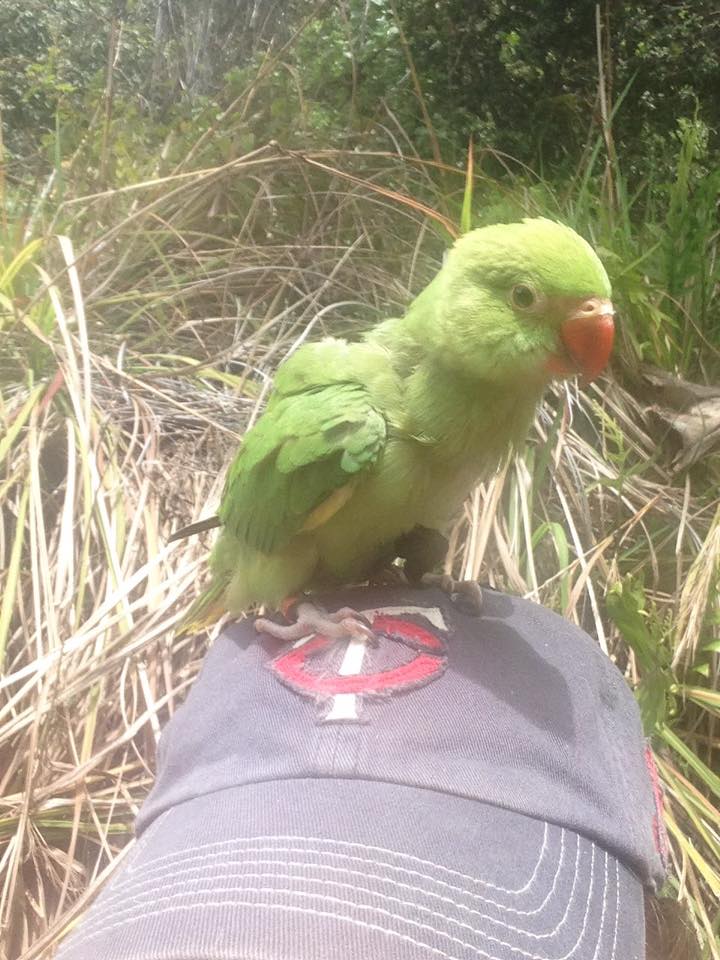The process of moving to Hawaii with any pet is daunting. Many people have heard horror stories of dogs and cats forced to stay in Rabies quarantine for months upon arrival and think “well birds don’t usually get Rabies, so we should be good, right?” Actually, bringing a bird to Hawaii is a whole different process than dogs and cats, because with birds they are more concerned with West Nile Virus than Rabies. Here are some steps to get you started. Remember, if the list below ever differs with information given by the Hawaii Department of Agriculture, please follow their instructions and disregard mine. This article is based on my experience transporting parrots from Georgia to Hawaii in 2014.
1.) Insure that your bird is on the list of Conditionally Approved Animals on the Hawaii Department of Agriculture web page. Because links can change I will not list it here but Google is a powerful tool. If it is not listed, your pet is not permitted and it is time to either choose a new place to move, or find a new home for your pet. Hawaii is VERY strict with all of the regulations they have set in place, and many lovely species are not permitted due to their potential to devastate the delicate balance of wildlife on the Islands.
2.) Find a vet EARLY, and take your birds for a visit. It can’t be just any vet though; it needs to be a vet willing to do several things for you:
- Contact the Hawaii Department of Agriculture and request, fill out, and update a Bird and Poultry Permit, you cannot request it yourself, they will only issue it to the veterinarian.
-Quarantine your birds in a mosquito-proof environment under their care for a minimum of 168 hours (seven days) and certify that the birds had no contact with mosquitoes during that time.
-Issue health certificates with very specific wording: that the bird has not been vaccinated with a live agent within the last 60 days, that the bird appears healthy, shows no signs of disease, and is free of external parasites. Make sure you check each of these with the actual veterinarian, not just with the clinic, my birds were almost stuck in Georgia because a vet tech told me she checked and it would be fine when she had not in fact checked it with the actual veterinarian, but with another tech. The vet was uncomfortable with signing something saying the birds had not been vaccinated, because he felt that I could have done it and just not told him, since he was not my regular vet. This is also one reason it is good to take your bird to the vet early – if there are any signs of disease they can be caught early, and not the day before you plan to get on a plane. Also, having the vet on record earlier will smooth things out if any questions come up about vaccines.
3.) You will need to file a Plant Import Permit Request yourself as soon as possible. This can be found on the Hawaii Department of Agriculture website as well. If you have difficulty finding it, do not hesitate to call them. Yes, your bird is a plant and needs this permit.
4.) If your bird doesn’t have a leg band or a microchip, get one. I suggest L&M Bird Leg Bands, again, Google makes them easy to find. They can send you a custom order of open leg bands. You must order the open ones, because closed ones can only be put on while the bird is still very young in the nest. Open leg bands are not ideal because they can be chewed and potentially partially opened posing a hazard to your bird. You can order a set of bands with all the same number, put it on your bird for quarantine and travel, and remove it afterwards, thus eliminating a lot of the risk. Then when you go to fly your bird again, you simply put another band with the same number right back on. Be sure to get the tools to put them on and take them off – do not try it with pliers as this will leave the band oddly shaped, and more likely to be partially opened and cause your bird injury. If your bird is large enough for an avian microchip that is also an option, though the technology to safely chip small parrots is not yet available.
5.) The exact shipping regulations will vary according to airline, your place of departure, bird species, age, number of birds, season, whether you are in the military, whether you are flying at the same time as your bird, checking them, or sending them as cargo. If you are shipping multiple birds some airlines, including Delta, will permit you to attach multiple carriers inside a large carrier and pay the fee for only the single large carrier. Parrots may not share individual spaces, all must be in different compartments. Be sure that your species is well secured for their chewing ability and are not able to reach one another’s toes to bite them. Use zip ties or other methods to attach moisture-rich fruits and veggies such as apples, grapes, and peppers to the inside of the carrier. Also include pellets and seeds, I like to cover the floor with loose food as if it were bedding to insure that even in a stressed state the birds have immediate access to food. A water bottle is also advised. If possible, teach your bird to use one before the trip. Carefully read the airline regulations on what kind of kennel can be used.
Your bird must leave the vet quarantine in mosquito proof netting, remain unopened, and arrive in Hawaii without any tears, holes, or other openings. If an opening of any kind is found in the barrier the birds will be shipped back to their place of origin at your expense; there is no quarantine station for birds in Hawaii. I put my two cat carriers inside a dog Kennel and secured them together with zip ties then covered the holes with duct tape on the outside. I then covered the openings with wire screen. Instead of cutting the wire to fit, I folded the extra pieces under so that they were between the parrots and the actual mosquito barrier, and then I did the same thing again with another layer. If you can get your hands on 100pmh tape use that, if not gorilla tape or duct tape, BE SURE IT IS SECURE, and keep in mind there will likely be extreme changes in temperature and humidity which will compromise the adhesive. I then wrapped the container in TWO layers of camping style mosquito netting cloth by setting the kennel in the center of the net and then pulling the edges up and tying them pony tail style on the top of the kennel. I did these separately hoping that if one tore the other would not. I also attached signs in red and black to the top and each side of the kennel begging the handlers to be gentle because my birds would be refused if the barrier was damaged. All told I had four mosquito-proof layers between my birds and the outside world.
6.) You can ONLY fly into Honolulu International Airport on Oahu, you will have to make additional arrangements to fly to other islands. Look up the hours for the department of agriculture quarantine office at the airport, and be sure that you will be landing with plenty of time to claim your birds. I suggest leaving at least two hours, more if you can. You only have 36 hours between leaving the vet and arriving in Honolulu, so plan your flight carefully. Keep in mind that some airlines do not allow pets to be flown if the outside temperature at the departure airport is too high or too low, so find these regulations and check the weather: be sure your birds will be allowed to leave at the time they need to. Once you arrive and secure your bags and transportation, ask an employee for directions to the Quarantine office and let them know you need to claim your pets. Be sure to hand carry copies of every piece of paper work with you and have ID on you as well as payment for release. You will need to extract your own birds from the carrier and hold them in such a way that their leg bands can be inspected. Once this has been verified you can take your bird home, just remember your bird must remain in the carrier until you are off airport property. Remember to secure pet-friendly lodging prior to departure, and a travel cage that is suitable for the bird to stay in for as long as necessary until a permanent cage is available; most carriers won’t be a pleasant place for your bird to stay for any longer than the flight.


Leave a Reply